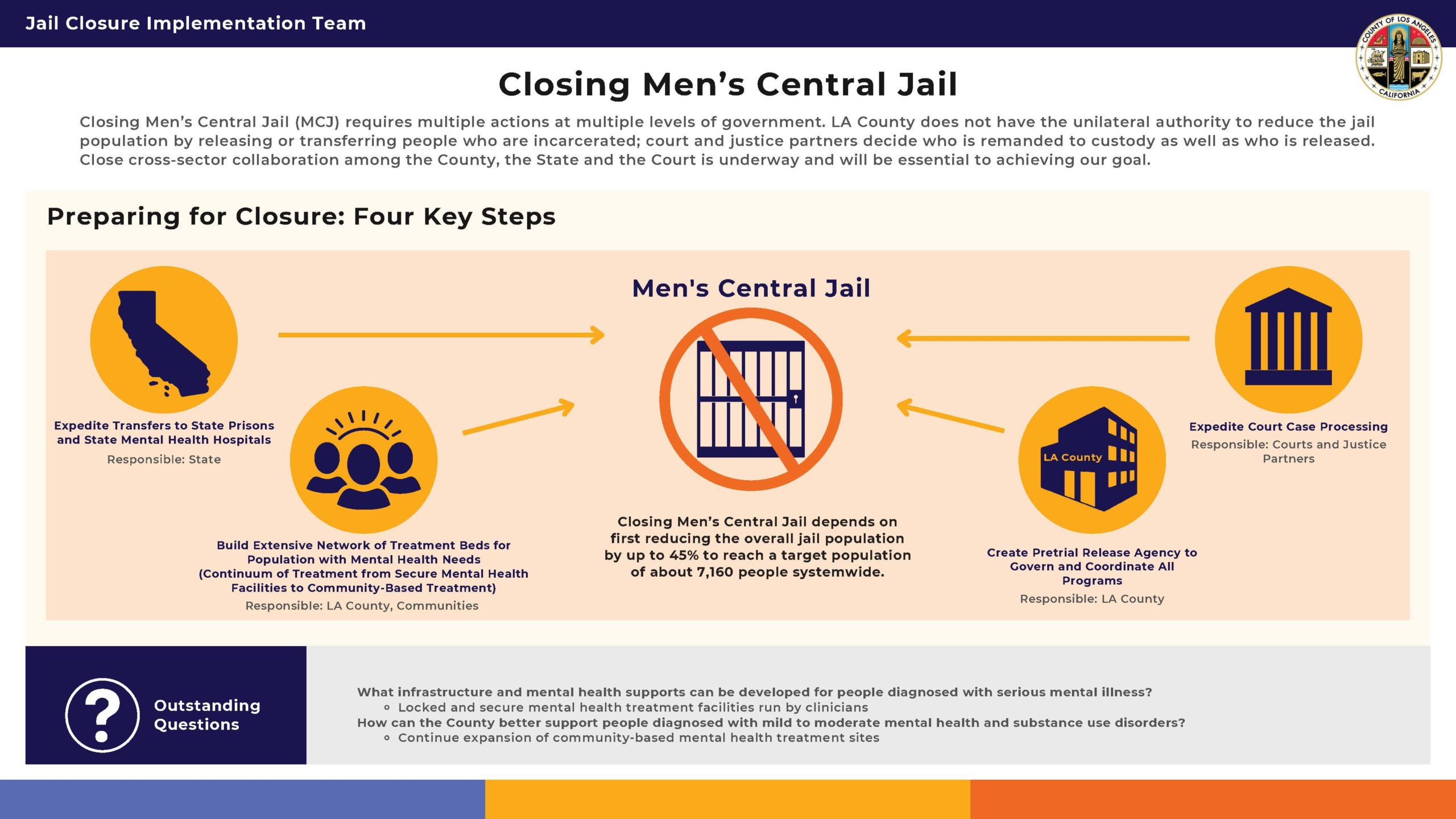

New name. Same mission.
Los Angeles County jails are overcrowded with individuals struggling with homelessness, poverty, mental illness, and addiction. The justice system is not equipped to address these issues, leading to a cycle of incarceration that does little to improve public safety. Instead of receiving the necessary support to build stable lives, many people are repeatedly jailed without meaningful intervention.
To address this, the County has rebranded the Jail Closure Implementation Team as the Community Safety Implementation Team (CSIT), aligning with the “Care First, Jails Last” approach. CSIT is focused on closing Men’s Central Jail and expanding community-based care, coordinating efforts across County agencies and community partners. By strengthening alternatives to incarceration, CSIT aims to safely reduce the jail population while prioritizing public health and safety.
Meet Wilford Pinkney, Jr.
Executive Director, CEO-Jail Closure Implementation Team
Wilford Pinkney Jr. joins the Chief Executive Office as the Executive Director of the Jail Closure Implementation Team in December 2024.
In a career spanning over 35 years, Mr. Pinkney has led public safety efforts using design thinking and system-building at the intersection of the justice, behavioral health, housing, education, and law—both nationally and locally.
Since 2018, Mr. Pinkney has worked in the City of St. Louis. As a FUSE Fellow, his efforts met and surpassed the initial goal of reforming the pretrial system—and better aligned the City’s resources, systems, and policies to enhance the early stages of the criminal justice process toward greater fairness.
At the conclusion of his FUSE Fellowship, he was appointed as the inaugural Director of the newly-created Mayor’s Office of Children, Youth, and Families for the City of St. Louis. Under his leadership, the City of St. Louis established a Crisis Management System, a Pretrial Services Office, the City’s first sobering center, and the creation of the Office of Violence Prevention. With the Office’s singular purpose of supporting St. Louis’ children and their families with resources to lead productive and successful lives, Mr. Pinkney led the City’s COVID-19 pandemic recovery efforts related to homelessness, rental assistance, early childcare, K-12 education, post-secondary education, maternal health, and summer youth programming.
Most recently, Mr. Pinkney served as the founding Director of the Office of Violence Prevention (OVP) for the City of St. Louis. OVP provides strategic direction and oversight for the City’s efforts create safe and healthy neighborhoods that are free from violence. OVP funds community-based organizations to connect community resources to the people who need them most, addressing the root causes of gun violence in a holistic way that cannot be done by law enforcement or local government alone.
Under Mr. Pinkney’s leadership, OVP collaborated with a range of partners to employ evidence-informed strategies (e.g., mediation, crisis management, and community- and hospital-based violence intervention) to support both youth and adults (e.g., victim and reentry services, youth diversion). As a result, St. Louis has become a leader in the national effort to reimagine public safety.
Mr. Pinkney’s leadership has contributed to notable public safety outcomes…
- Over 40% decrease in homicides since 2020 and a 30% reduction in overall crime in the last two years
- 17% fewer shooting incidents and a 45% reduction in juvenile shooting incidents in the last two years
- 50% reduction in the jail population from 2018 to 2021 that resulted in the closing of one of the City’s jails
- Over 40% reduction in Behavioral Health Crisis calls for St. Louis Fire Department Emergency Medical Services (EMS)
- Over 50% reduction substance use calls for St. Louis Fire Department EMS
…and the development of sustained community infrastructure:
- Established 44 ‘Virtual Learning Centers’ that supported students in remote learning
- Launched a program that housed 100 people experiencing chronic homelessness in 100 days
- Launched a program that has distributed over 1 million meals to children during the COVID-19 pandemic
- The planning and launch of five (5) emergency shelters in response to the pandemic
- The distribution of $2.1 million in CARES Act funds to provide emergency assistance to early childcare providers
- Securing $1.8m in federal grants for public safety projects focused on assisting those with mental health and co-occurring disorders
Mr. Pinkney’s leadership approach draws from his diverse experiences. He is the Founder and CEO of Puissance Management & Consulting, LLC., which helps organizations develop systems to innovate and implement approaches to today’s problems while anticipating future ones. He has also served as Chairperson of the School of Criminal Justice at Monroe College where he developed and oversaw the academic curriculum for the program’s roughly 2,000 students and 100 faculty members. Early in his career, Mr. Pinkney served as a member of the New York City Police Department, on assignments such as: community policing; dignitary protection; hostage negotiation; gang/violent crime investigations; and policy analysis and planning. His time as a community police officer—and subsequent experiences—reinforced the importance of working with community to solve problems.
A graduate of Mercy College, Mr. Pinkney earned a master’s degree in public administration from New York University, and master’s in political science from the CUNY Graduate Center. He is currently a doctoral candidate in Political Science at the CUNY Graduate Center.

Strategic Approach
The Board of Supervisors directed CSIT to coordinate the depopulation work of the County to determine how to safely and methodically close Men’s Central Jail. To accomplish its mission, CSIT has defined three organizing levers for this work.
Reducing Inflow
Redirecting people away from the County jail system.
Reducing Length of Stay
Speeding up court-related processing (irrespective of the case outcome).
Increasing Outflow
Facilitating release for people already in County jail custody.
Our Progress to Date
On June 22, 2021, the Board of Supervisors approved a motion to create the Jail Closure Implementation Team to distill the various recommendations from the inventory of studies and reports concerning the closure of Men’s Central Jail and to develop actions, goals and associated timelines to safely and methodically depopulate and close the jail.
In September and October of 2021, a small and nimble County team was formed to staff JCIT, comprised of County staff who have worked extensively in the areas of law, justice reform, mental health, health services, homeless services and child welfare.
Overcrowding at the Inmate Reception Center
With the sunset of the statewide emergency bail schedule imposed during the COVID-19 pandemic, jail bookings have increased, leading to concerns about overcrowding and long wait times for processing at the Inmate Reception Center in downtown Los Angeles.
On June 28, 2022, the Board of Supervisors directed the JCIT and Alternatives to Incarceration Initiative to collaborate with the Sheriff’s Department, Correctional Health and other pertinent departments to develop a proposal for using AB109 funding to address the overcrowding.
On August 3, 2022, the JCIT offered a preliminary set of strategies for mitigating overcrowding, including hiring registry positions to fill clinical vacancies; making physical modifications to staging space in Twin Towers; adding clinical space for medical and mental health screenings and evaluations; and conducting legal analysis regarding targeted pre-trial releases of individuals awaiting trial on non-violent felony and misdemeanor charges.
The initial report is linked below. Progress on this front will be discussed in future JCIT quarterly reports to the Board.
JCIT Progress Reports
Gender Responsive Advisory Committee
Recommendations of the Gender Responsive Advisory Committee—which also includes two spirit, lesbian, gay, bisexual, questioning and transgender, gender non-conforming and/or intersex individuals as part of its target population—also inform JCIT’s work.
On October 19, 2021, the Board directed JCIT to prioritize recommendations by the GRAC to:
— Expand the community-based system of care for cisgender women and 2S-LGBQ+TGI individuals housed at Century Regional Detention Facility and the K6-G units at Twin Towers Correctional Facility;
— Contract for an updated population study of both groups; and
— Promote gender-responsive, trauma-informed services and programming in the jails.
More information on GRAC’s work can be found here:
Frequently Asked Questions
Successful closure of Men’s Central Jail (MCJ) will require a reduction of the jail population by about 6,000 people or a decrease of roughly 45% from current levels. Since early 2020, the population has been reduced by approximately 4,000 people, driven by priorities that the Jail Closure Implementation Team (JCIT) is continuing to support, including:
- The issuance of citations instead of detention for misdemeanor, non-violent and non-serious charges
- Aggressive pretrial release of individuals who were primarily charged with non-violent felonies
- Increased access to diversion programs
Successful closure of Men’s Central Jail will require a reduction of the jail population to roughly 7,160 people or a decrease of roughly 45% from current levels. To accomplish that goal, JCIT needs the cooperation of various justice, governmental and community partners.

Roughly 60% of those who now remain jailed are charged with or sentenced for committing serious or violent felonies. The number charged with felony drug or misdemeanor offenses is each less than 5%. It is estimated that half of the jail population has a mental health need, with 20% diagnosed with a serious mental illness. Approximately 5% of the custody population is awaiting placement to a mental health facility. While approximately 45% of the jail population is being held prior to trial, most of these individuals are charged with serious and violent felonies. The Court is unlikely to release these individuals into the community, particularly those in need of mental health treatment that pose a grave danger to themselves or others. Other individuals may be incarcerated based on holds from other jurisdictions or due to multiple charges, complicating the potential for release. The majority of those detained are men; women comprise roughly 10% of the jail census. Roughly 54% are Hispanic, 29% are Black, 13% are white and the remaining 4% identify with other racial and ethnic designations.
JCIT has identified several methods to reduce the jail population, including:
- Creation and implementation of a Custody Alternatives Team to recommend release, when appropriate
- Expedited court case processing to reduce the length of stays
- Consolidation and expansion of available pretrial services
- Acceleration of transfers to state hospitals and state prisons
- An increase in the number of available secure local mental health facilities
However, the Board of Supervisors and the CEO do not have authority over the Court or other entities that can directly influence jail release or other court processes. The options above will take time as they depend upon building a track record of success and establishing partnerships among the Court, justice partners (e.g., District Attorney, Public Defender, Alternate Public Defender and Sheriff), community-based organizations, and County programs available to support people outside of custody.
Decreasing the jail population by 45% is roughly equivalent to the release of 100% of the individuals currently being held pretrial. While the Court is ultimately responsible for making release decisions, it is unlikely to release large numbers of individuals held on serious or violent felony charges—which includes the majority of people currently held in the County jail system—without significant investment and expansion of the infrastructure available to support a person if released.
The County can provide options to support Court release from custody by offering diversion programming and establishing a Custody Alternatives Team (CAT). A CAT would allow justice partners to build consensus around cases to present to the Court for release consideration.
Based on reasonable case review workloads 1 and the probability of release, 2 the County could expect the release of 40-120 individuals per year through a CAT, though this number could increase with dedicated staff and additional resources. This represents small incremental gains against the goal of reducing the jail population by roughly 6,000 people in total.
Additional progress could be made by expediting court processing, reducing court continuances, and swiftly dispositioning backlogged cases. The 2021 JFA Institute report estimated this could result in a reduction of about 2,000 jail beds. This work is outside the County’s control and relies on the Court.
Rapid transfers to both state prisons and state hospitals are critical to maintaining a lower population. State prison transfers have resumed, while the number of people awaiting transfer to state hospitals has grown by more than half since September 2021. Currently, nearly 700 individuals await state hospital transfer.
About 20% of the jail population has significant to severely debilitating mental health needs that would require treatment in secure mental health facilities if they were to qualify for release.
To fund these beds, the County will need to rely on Medi-Cal funding that cannot be used for facilities with more than 16 beds without receiving the appropriate waiver. Absent a change to federal Medicaid regulations (which would require an act of Congress) or support to build a locked, County-operated mental health treatment facility, it is estimated that between 80-100 such small facilities would need to be built to accommodate this population.
Based on the County’s experience in other similar projects, securing locations to establish such facilities could be sensitive and require significant time, community and stakeholder engagement and education, as well as financial investment.
To fulfill the County’s goal of safely depopulating and closing MCJ as soon as possible, it will be necessary to:
- Continue facilitation of state prison and state hospital transfers
- Work with the Court and justice partners to persuade them to expedite criminal case processing
- Implement a CAT to build consensus around recommendations for release
- Build locked and secured mental health treatment facilities run by clinicians
- Lobby to have the Medicaid Institutions for Mental Disease exclusion waived
- Facilitate transfers between existing County jail facilities with suitable vacant space Continue development of a consolidated pretrial services agency to increase access to available reentry services, including expansion of pre-plea and rapid diversion programs and increased workforce development support
As the County continues to make progress in the efforts identified above, a more reasonable and accurate timeline to safely accomplish MCJ closure will develop.

